Bayeux Tapestry: The story in six scenes
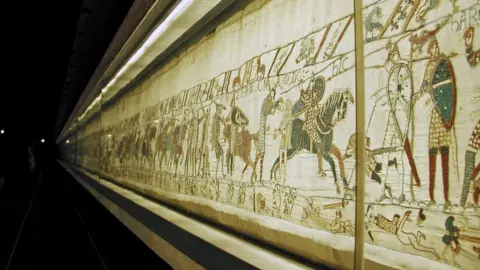 Shutterstock
ShutterstockA 70-metre long tale of broken oaths, revenge and bloodshed is set to be displayed in the UK.
No, it's not the latest Eastenders script but the Bayeux Tapestry, an embroidered story of the Norman takeover of England, including one of the most famous battles in British history.
After 950 years on French shores, President Emmanuel Macron is expected to loan it to the UK but it won't arrive until 2020.
Here's the story in six key scenes, as described by Reading Museum, where a replica of the tapestry is housed, and history lecturer Dr Levi Roach.
The images below are taken from the replica, which is slightly different from the original.
1. Harold makes a solemn oath
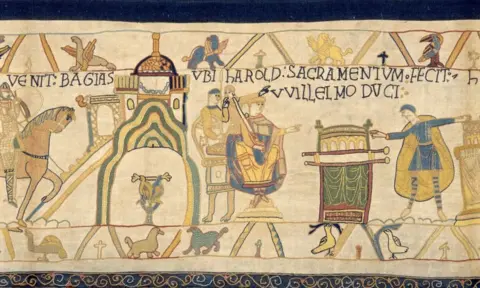 Reading Museum / Reading Borough Council
Reading Museum / Reading Borough CouncilIt's 1064 and Harold, the Earl of Wessex, has been rescued by William of Normandy after becoming shipwrecked in northern France.
While there, Harold swears an oath on holy relics. The Latin description of Harold's promise does not say what this oath is but it is widely recognised as being in support of William of Normandy succeeding Edward as king of England.
Harold's brother-in-law King Edward, also known as Edward the Confessor, has been on the throne since 1042.
Medieval history lecturer at the University of Exeter Dr Levi Roach says oaths were used as a "very sure form of providing assurance that you would do something" - like a "kind of down payment".
"There are tales of saints wreaking vengeance on those who break their oath," Dr Roach says.
2. Edward's funeral
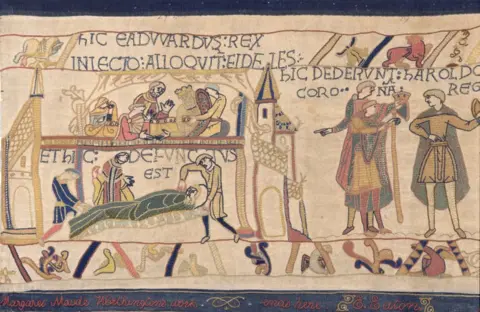 Reading Museum / Reading Borough Council
Reading Museum / Reading Borough CouncilOn 5 January 1066, King Edward dies and the big question in this scene is: "Will Harold stick to his oath?"
The tapestry shows the king's funeral at Westminster Abbey and Harold breaking his promise by accepting the offer to become the new king of England.
This scene is one of the first depictions of the abbey in history, Dr Roach says.
King Edward transformed it from a small monastery into a significant abbey, knowing it would one day be his final resting place, he adds.
3. Building the ships
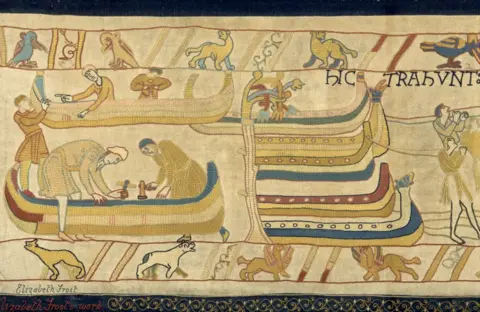 Reading Museum / Reading Borough Council
Reading Museum / Reading Borough CouncilHarold is crowned King of England - news which soon spreads across the Channel to William.
William claims the throne should be his and decides to attack.
He and his men get to work preparing ships to cross to England and fight back against Harold.
Dr Roach points out that the ships nod to the Norman's sea-faring past with their links to Vikings.
However, he says it also shows the "scale of the venture" because there were not nearly enough ships for the expedition.
4. William has a discussion with his half brothers and a castle is built
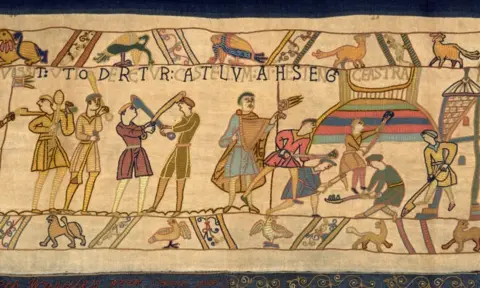 Reading Museum / Reading Borough Council
Reading Museum / Reading Borough CouncilOn 28 September 1066, William's army reach land at Pevensey Bay in East Sussex and march on to Hastings.
One of the first things William does is build a castle.
"Castles are new to the British Isles, but not the world - this is one of the key features of continental culture the Normans bring with them and becomes a characteristic feature of the conquest," Dr Roach says.
5. William raises his helmet after a fall from his horse
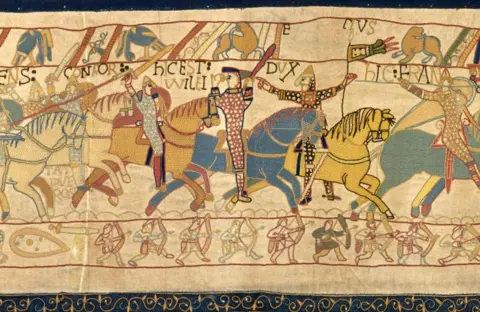 Reading Museum / Reading Borough Council
Reading Museum / Reading Borough CouncilAlmost a month later, the pair are ready to face each other and battle over who should rightfully be on the throne.
After a fall from a horse, William's troops are not sure he's still alive and are thinking about retreating.
He lifts his helmet to show his face and encourage his men to fight on.
With his armour on, he looked much like any other soldier. Dr Roach says this battle came before coats of arms were incorporated into armour to identify the soldiers.
6. The death of Harold
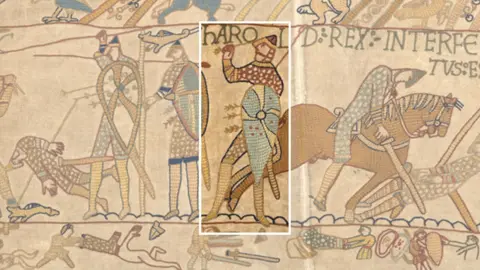 Reading Museum / Reading Borough Council
Reading Museum / Reading Borough CouncilThe end of the battle and Harold's death is regarded as the "most famous" scene from the tapestry.
It is the moment that decides the closely fought battle, says Dr Roach.
He describes it as the "climax of the entire drama being told by the tapestry", saying "Harold is now getting his comeuppance, the oath breaker gets his revenge".
But which one is he? The myth goes that Harold was killed by an arrow in the eye, as highlighted in our picture, but historians are not entirely sure that's him.
Images courtesy of Reading Museum's replica tapestry
